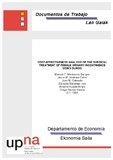Mostrar el registro sencillo del ítem
Cost effectiveness analysis of the surgical treatment of female urinary incontinence using slings
| dc.creator | Montesino Semper, Manuel F. | es_ES |
| dc.creator | Jiménez Calvo, Jesús M. | es_ES |
| dc.creator | Cabasés Hita, Juan Manuel | es_ES |
| dc.creator | Sánchez Iriso, Eduardo | es_ES |
| dc.creator | Hualde Alfaro, Antonio | es_ES |
| dc.creator | García García, Diego | es_ES |
| dc.date.accessioned | 2016-05-10T07:39:58Z | |
| dc.date.available | 2016-05-10T07:39:58Z | |
| dc.date.issued | 2013 | |
| dc.identifier.uri | https://hdl.handle.net/2454/20549 | |
| dc.description.abstract | Objective. To determine the cost-utility and cost-effectiveness of the surgical treatment of female urinary incontinence using suburethral slings compared with therapeutic abstention. Study Design. An economic analysis was performed on 69 women receiving surgical treatment for urinary incontinence using suburethral slings. To calculate the procedure´s cost-effectiveness, an incremental analysis up to 1 year was performed using the incremental cost-effectiveness ratio (ICER). The costs were calculated using a cost-by-process model. Answers to the health-related quality of life questionnaires EQ-5D (generic) and International Consultation Incontinence Questionnaire Short-form (specific) were collected before the operation and as well as 1 month and 1 year post-operation to calculate the utility, using quality-adjusted life years (QALY), and the effectiveness, respectively. A sensitivity analysis was performed by calculating the Incremental Cost-Effectiveness Ratio (ICER) at 5 years post-operation. To complete the economic evaluation, we derived confidence ellipses and acceptability curves. The analysis was conducted for the entire sample and also for each type of urinary incontinence. Results. In total, 45 women presented with stress incontinence, 15 with mixed incontinence and 9 with incontinence associated with prolapse. The average cost per patient at 1 year post-operation was 1,220 €. The QALY achieved at 1 year was 0.046. The results reveal an ICER at 1 year of 26,288 €/QALY, which is below the cost-effectiveness threshold considered acceptable, and this value was lower for stress incontinence (21,191 €/QALY). To achieve greater temporal perspective, we examined the ICER at 5 years, which was 10,141 €/QALY, demonstrating that the programme is clearly efficient. The cost-effectiveness was 106.5 €/ International Consultation Incontinence Questionnaire Short-form unit. Conclusion. Surgery for female urinary incontinence using slings is cost-effective compared with abstention in our public health environment. | en |
| dc.format.extent | 21 p. | |
| dc.format.mimetype | application/pdf | en |
| dc.language.iso | eng | en |
| dc.relation.ispartofseries | Documentos de Trabajo DE - ES Lan Gaiak | es |
| dc.relation.ispartofseries | 1303 | en |
| dc.rights | CC Attribution-NonCommercial-NoDerivatives 4.0 International (CC BY-NC-ND 4.0) | en |
| dc.rights.uri | https://creativecommons.org/licenses/by-nc-nd/4.0/ | |
| dc.subject | Female urinary incontinence | en |
| dc.subject | Surgical treatment | en |
| dc.subject | Cost-utility analysis | en |
| dc.subject | Cost-effectiveness | en |
| dc.title | Cost effectiveness analysis of the surgical treatment of female urinary incontinence using slings | en |
| dc.type | Documento de trabajo / Lan gaiak | es |
| dc.type | info:eu-repo/semantics/workingPaper | en |
| dc.contributor.department | Economía | es_ES |
| dc.contributor.department | Ekonomia | eu |
| dc.rights.accessRights | Acceso abierto / Sarbide irekia | es |
| dc.rights.accessRights | info:eu-repo/semantics/openAccess | en |



